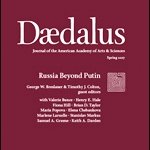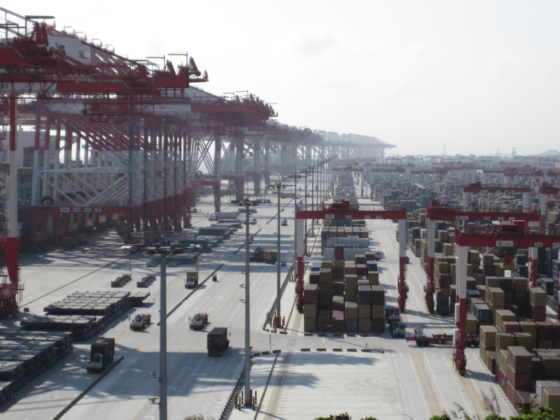(Daedalus) The current issue of Dædalus represents a collaborative effort to think afresh about Russia’s political future. The long and eventful reign of Vladimir Putin, commenced in 2000, is well into its second half. The time horizon we work with in our discussion is roughly ten to fifteen years out. By then, Putin, if alive, will be in his mid-seventies (he turns sixty-five in October 2017) and will either be out of power or in his endgame as national leader.
Our shared goal in this collection is to reach for answers to a pair of linked questions about what will happen to Russia’s increasingly arbitrary political regime as the Putin era winds down. First, what are the prospects either for a fundamental change that would realign the whole system, or for significant within-system change that would modify it or improve its functioning, without transforming it? Second, if change were to occur, what direction can it be expected to take? Will it be toward a more open and democratic political order, toward a more closed and authoritarian political order, or toward destabilization and disorder? These questions are easy enough to pose but not so easy to answer. Prediction, as the great physicist Niels Bohr famously put it, “is very difficult, especially if it’s about the future.”
Two thousand seventeen marks the centenary of the Russian Revolution that toppled tsarism and eventually swept the Bolsheviks to power. The anniversary serves as a reminder that wrenching change has been the rule, not the exception, in modern Russia in all three of its successive forms–imperial, Soviet, and post-Soviet. Scholars have often been guilty of underestimating the potential for change in Russia. Yet it does not follow, of course, that with this next turn of the wheel meaningful change is inevitable, let alone that any change, massive or modest in scope, will be benign or of the sort Western observers would approve. Next door to today’s Russia, the “Euromaidan revolution” in Ukraine, named after the square in Kiev where public protest led to the overthrow of President Viktor Yanukovych in 2014, is indicative of the possibilities of radical political change in the post-Soviet space. But Ukraine’s patchy record with reforms since then shows the need to be cautious in forecasting lasting improvement, and the danger of equating stirring words with effectual deeds.
This issue of Dædalus begins with my brief exploration of some of the “paradoxes of Putinism” as a system. It concludes with reflections by my coeditor, George Breslauer. The meat in the sandwich is the set of ten essays probing what we speculate are the most plausible sources of stress and change in the politics of Russia. The approach is selective, not comprehensive, targeting phenomena that seemed to us to have the greatest potential as generators of change. These phenomena consist of objective factors and trends (in the economy, for example), subjective ideas and perceptions (about, say, religion or the family), and interested groups (such as business executives or nationalist agitators). Most of our authors, while anchoring themselves in one of these main categories, work with combinations of the three, reflecting the way the categories overlap and intermesh in real life.
The contributors are among the best and brightest in the field. They have all done creative and well-regarded work on the aspect of the question with which they have been paired, as well as on a range of other issues, related and unrelated. The essays are independently written, but were circulated for comment within the group and in draft form, and were the focus of a lively authors’ workshop organized by the American Academy in June 2016.
Valerie Bunce, who has written extensively about the “color revolutions” against authoritarian and semiauthoritarian governments in Eurasia and Eastern Europe, opens the conversation broadly by addressing Russia’s vulnerability to this kind of protest-based upheaval. Henry Hale peers at Russia through the lens of his concept of Russia’s (and many of its neighbors’) “patronal” political order, which has so far been remarkably resilient, and asks whether and for how long the arrangement can be extended.
The collection then bears down on political institutions. Fiona Hill takes on the institution at the heart of the status quo in Russia–the presidency–and considers the possibility that the personalization of power since 2000 has created a Kremlin succession problem not so very different from the one that haunted Soviet leadership. Brian Taylor, an expert on Russia’s military and police establishments, writes about the possible role of the siloviki, or “men of force,” from the security and military establishments, the very cadre from which Vladimir Putin emerged in the 1990s. Maria Popova, drawing on her research about courts and prosecutors in the region, ponders the chances of movement toward greater ruleof-law.
We then shift gears toward broader social constituencies outside the corridors of power. Elena Chebankova, a student of Russian ideas and political practice, explores the stabilizing role of what she calls “paradigmatic pluralism,” in which a traditionalist ethos is ascendant but exists in tension with Western-type liberalism. Marlene Laruelle shines a spotlight on Russian nationalism, which she looks at through the behavior of three types of nationalists: non-state, parastate, and state actors. Stanislav Markus brings into the picture Russia’s “oligarchs,” the super-rich beneficiaries of the redistribution of resources after Communism; he parses them also into three categories, which he identifies as the friends of those in power, “silovarchs” (oligarchs with connections to the security establishment), and outsiders. And Samuel Greene analyzes protest activity and the changing condition of the “social contract” between Russian society and the Putinist state.
In a final essay before the wrap-up, Keith Darden moves us to the international dimension. He takes the measure of external threats, real and imagined, as a driving force in Russian domestic affairs.
George Breslauer’s conclusion pulls the threads, or a number of them, together and lays out in summary form some of the possibilities for Russia beyond Putin. Breslauer points out that none of our authors forecasts a change of political system in Russia, but notes that within-system change, short of a breakout from the status quo, is entirely possible in our time frame. Such change may be morally repellent or attractive to the outsider, depending on that person’s point of view, and the same applies to the citizens whose lives are bound up with the current political order.
– Timothy J. Colton
Read More © Daedalus | MIT Press Journals | American Academy of Arts & Sciences










